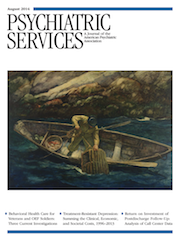This Month’s Highlights
Treatment-Resistant Depression: A Heavy Burden
The direct and indirect costs associated with treatment-resistant depression contribute substantially to total U.S. costs for major depression, which were $187 billion per year in 2012, placing the societal burden of depression on a par with cancer ($131 billion) and diabetes ($173 billion). These figures are derived from data compiled by David A. Mrazek, M.D., and colleagues, who undertook a systematic literature review (1996–2013) to assess clinical, societal, and economic outcomes associated with treatment-resistant depression. Their review of 62 articles (N=59,462 patients) found that 12% to 20% of patients with major depressive disorder are unresponsive to one or more trials of drug therapy. These patients have only a 20% probability of achieving remission in the course of treatment, and the prevalence of prior suicide attempts is 17% in this group. The number of general medical visits each year among patients with treatment-resistant depression is three times that in the general population (28.3 versus 8.7). The findings “underscore the need for research on the mechanisms of depression, new therapeutic targets, existing and new treatment combinations, and tests to improve the efficacy of and adherence to treatments for treatment-resistant depression,” the authors concluded (page Original article: 977).
VA Behavioral Health Care: Three Studies
Three studies examine use of and satisfaction with care provided by the Department of Veterans Affairs (VA). Kimberly A. Hepner, Ph.D., and colleagues analyzed data from telephone interviews conducted in 2008 and 2009 with 5,185 veterans who had used VA behavioral health care in the past year. Half reported receiving routine appointments as soon as requested, and 42% were highly satisfied with their care. Although three-quarters said that treatment helped, only 32% reported symptom improvement. Satisfaction levels were much lower for patients with substance use disorders, suggesting that they may have unique expectations that are not being met (page Original article: 988). A study from the Walter Reed Army Institute of Research is a call to action to validate interventions to improve postdeployment engagement and retention in PTSD treatment. Charles W. Hoge, M.D., and colleagues looked at data from groups of soldiers after their deployments and found that among 4,674 soldiers referred to mental health care at a military treatment facility, 75% followed up with the referral. Of 2,230 who received a PTSD diagnosis within 90 days of returning from Afghanistan, 22% had only one mental health visit and 41% received minimally adequate care (page Original article: 997). What can be done to retain veterans in treatment? Jennifer M. Aakre, Ph.D., and colleagues sought to answer this question in a study of Iraq and Afghanistan veterans who entered a specialty outpatient program for treatment of PTSD. Retention rates were significantly higher among veterans who had received mental health services in the past. Successful participation in therapy, the authors noted, often requires a series of attempts at, and returns to, treatment, and it may be unrealistic to expect mental health care systems to achieve high utilization rates when a significant number of patients are new to treatment, as in the VA (page Original article: 1066).
Focus on Treatment Engagement
Helping patients stay in treatment is an important goal for providers, as demonstrated in two reports. Providing follow-up calls to patients after they leave the hospital can help them stay connected to community providers. Many hospitals have contracted with call centers to provide these calls. Because reducing costly readmissions is a primary goal, John S. Richardson, M.P.H., and colleagues estimated the return on investment (ROI) for follow-up calls made by eight call centers in seven states to patients with suicidal ideation or deliberate self-harm who had been discharged from a hospital or emergency department. The estimated ROI (for every $1 invested) was $1.76 for commercial insurance and $2.43 for Medicaid for patients discharged from a hospital and $1.70 and $2.05, respectively, for patients discharged from an emergency department. “The study supports the business case for payers, particularly Medicaid, to invest in postdischarge follow-up calls,” the authors concluded (page Original article: 1012). In a study of clinic attendance in a sample of mostly Spanish-speaking Latino clients at 12 community mental health clinics across the country, Gabriela L. Stein, Ph.D., and colleagues identified clinic characteristics associated with treatment engagement. Having dedicated outreach staff was associated with fewer missed appointments. However, some clinic characteristics designed to improve engagement, such as case management and transportation vouchers, were associated with worse outcomes (page Original article: 1020).



